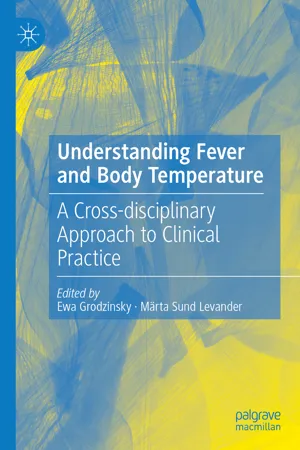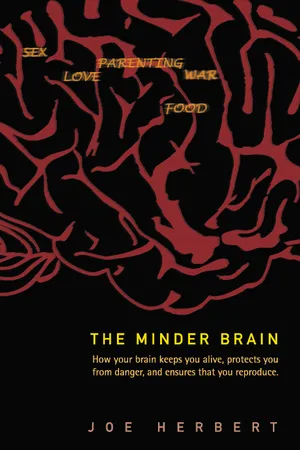Biological Sciences
Control of Body Temperature
The control of body temperature refers to the physiological mechanisms that maintain the body's internal temperature within a narrow range, typically around 98.6°F (37°C). This process involves the coordination of various systems, including the nervous system, endocrine system, and skin, to regulate heat production and loss. Key components of temperature regulation include shivering to generate heat and sweating to dissipate heat.
Written by Perlego with AI-assistance
Related key terms
6 Key excerpts on "Control of Body Temperature"
- eBook - ePub
Understanding Fever and Body Temperature
A Cross-disciplinary Approach to Clinical Practice
- Ewa Grodzinsky, Märta Sund Levander, Ewa Grodzinsky, Märta Sund Levander(Authors)
- 2019(Publication Date)
- Palgrave Macmillan(Publisher)
set point ’ model, makes it possible to include non-thermal factors and their impact on thermoregulation.How to Maintain Normal Body Temperature
To maintain an internal-deep-body temperature within a normal range is crucial for the body since many physiological processes are at their optimum within a very narrow range of body temperatures. Heat balance is, under normal circumstances, maintained by behaviour and physiological reactions. Behaviour plays a very important role, especially when ambient temperature reaches outside the thermoneutral zone (TNZ), when regulatory changes in either heat production or heat loss are needed. To adjust the rates of heat loss and heat gain , humans use a variety of behaviours. For example, appropriate actions include seeking the shade, avoiding wind and wetness, increasing or decreasing physical activity, and wearing suitable clothing [14 ]. Physiological reactions involve the cardiovascular system , the sudomotor control, and metabolism.Cardiovascular System
A vital part of the body’s temperature regulation is changes in skin blood flow. Regulation of body temperature is primarily controlled through changes to blood perfusion by vasodilatation or vasoconstriction in subcutaneous blood vessels. In a resting state and with a thermoneutral surrounding, skin blood flow represents approximately 5% of cardiac output, which is about 0.3 litre/min. When heat gain is increased, as in physical activity in hot ambient temperatures, skin blood flow can increase up to 60% of the increased cardiac output, that is, about 8 litre/min [15 , 16 ]. However, these increased physiological demands require a strong and healthy heart and circulatory system. The most common vascular construction in the skin is arteries coupled to veins via capillaries. Fewer in number are the direct artery-vein connections, the so-called arterial venous anastomoses. These are mainly found in the skin of acral areas like the hands and fingers, feet and toes, nose, lips, cheeks, and ears. When the blood flows through artery to venous anastomoses, the heat loss is less substantial than when passing through capillaries [9 - eBook - ePub
The Thermal Human Body
A Practical Guide to Thermal Imaging
- Kurt Ammer, Francis Ring(Authors)
- 2019(Publication Date)
- Jenny Stanford Publishing(Publisher)
Houdas and Ring described the state of art of the time in an easy understandable way when they published their book Human Body Temperature in 1982 [ 3 ]. In the 1990s, evidence was raised that sympathetic nerve fibres control both vascular skin responses to thermal stimuli, vasodilation in case of heat load and vasoconstriction in case of heat loss. Recently the model of a single central temperature control was rejected and exchanged with several control loops integrating deep and superficial body temperatures [ 4 ]. However, the traditional temperature regulation model described by Houdas and Ring is still useful to understand the principle of human thermoregulation. 3.2.1 Anatomical and Physiological Systems It became obvious from early temperature measurements in men and animals that the distribution of temperature is not homogeneous in living bodies. Temperature distribution differs between species as different adaptation to the temperature environment of living beings have emerged. One group are homeotherm animals such as mammals, which can maintain their deep body temperature within a narrow range. This became possible through physiological processes, which actively counteract the equilibration between the heat energy stored in the living body and the heat content of the environment. Temperature regulation is an important physiological subsystem, functioning in close relationship with the circulations system using the vascular network to transport heat by conduction from deep body tissue to the surface. There is also a strong dependence from the system that controls fluid haemostasis, as sweating is an important mechanism for dissipating heat. The autonomic nerve system controls the smooth muscles of the vascular walls, changing in that way the inner width of blood vessels and thus controlling blood flow and blood distribution - eBook - ePub
- Ken Parsons(Author)
- 2019(Publication Date)
- CRC Press(Publisher)
This is the environment on earth on which organisms survive. One strategy for survival in this varied environment is for an organism to maintain a relatively constant internal environment where it carries out essential functions despite variation in the external environment. It usually does this by varying the condition of the outside of its body to maintain conditions relatively constant inside. This is called homeostasis, and was described by Claude Bernard in his work on what he called the “internal milieu.” All mammals, including humans, practice homeostasis, and in terms of maintaining a relatively constant internal temperature, they are called homeotherms. People “attempt” to maintain an internal body temperature of around 37°C and usually within the range 36.5°C–37.5°C. To achieve this, all people have a system of thermoregulation.Human Thermoregulation
Heat stress occurs when the environment creates conditions where the internal body temperature of a person has a tendency to rise. Generally, the human response to the heat stress is to attempt to increase heat loss from the body to the environment or reduce heat gain to the body from the environment. This thermoregulation occurs as two types. One is mainly conscious, where a person will respond to discomfort or dissatisfaction by taking action (e.g., moving away, adjusting clothing, opening a window, or switching on a fan). This is called behavioral thermoregulation or an adaptive approach. The second is an unconscious, automatic, and continuous system called physiological thermoregulation. The systems work together and are shown in Figure 2.1 .FIGURE 2.1 A diagrammatic representation of human thermoregulation. Behavioral regulation is controlled by the conscious cortex and mostly requires a conscious decision. Physiological regulation is continuous and automatic and controlled by the hypothalamus.Physiological Thermoregulation
The physiological system of thermoregulation can be conveniently divided into two parts, the controlled system and the controlling system. The controlled system is often called the passive system as it represents the nonactive part of the human body. That is the skin, fat, muscle, bone, organs, head, hands, feet, arms, legs, trunk, lungs, blood, lymph, and so on. The dimensions, shapes, and thermal properties of the components of the passive system will be important in thermoregulation. The controlling system controls the state of the passive or controlled system in an “attempt” to ensure that the internal body temperature can remain at around 37°C through loss of excess metabolic heat and gain from the environment. The controlling system therefore has a system of detection and transmission, a system of integration and processing, and a system of effecting physiological response (e.g., vasodilation and sweating). It is a reasonable assumption that the regulated or controlled variable is related to the internal body temperature which is an integrated value of the temperature of the vital organs and brain. - eBook - ePub
The Physiological Basis of Behaviour
Neural and Hormonal Processes
- Kevin Silber(Author)
- 2005(Publication Date)
- Routledge(Publisher)
6 HomeostasisIntroduction
In this chapter we consider homeostasis as an example of how the CNS, ANS and endocrine system work together. The term homeostasis refers to the maintenance of a relatively stable state within our bodies. In the first part of the chapter we take a closer look at exactly what this means. The rest of the chapter details three major homeostatic mechanisms, namely, the regulation of our nutritional content (eating), the regulation of our water content (drinking), and the regulation of our body heat (temperature regulation). As you work through the chapter you will see that all three mechanisms are kept in balance by a combination of hormonal and ANS activity, all of which is coordinated by central brain processes.What is homeostasis?
There are a number of features of homeostasis that are worth pointing out before we look at the details.As I am writing this book in World Cup year I will start, if I may, with a football analogy. Imagine that you want to have a game of football. If the ball is not pumped up enough then it will not bounce properly. If it is blown up too much then it will burst. Indeed, professional footballers will tell you that small diversions from the correct pressure make it difficult to play properly. There is, therefore, a limited range of pressures over which the football can function as a football. The same is true of the constituents of our bodies. For example, many of the chemical reactions in our body are helped by the presence of enzymes. Enzymes will only work within a limited temperature range. Therefore, the body must maintain its temperature within certain limits. The mechanisms for this and all of the other balances are called homeostatic mechanisms.- The ideal range for any component is called the set point
- eBook - ePub
The Minder Brain
How Your Brain Keeps You Alive, Protects You from Danger, and Ensures that You Reproduce
- Joe Herbert(Author)
- 2007(Publication Date)
- WSPC(Publisher)
International encyclopedia of pharmacology and therapeutics. Eds. E Schonbaum, P Lomax, pp. 53–183. (Pergamon Press, New York)A homeostatic regulation implies regulated level of some variable that is sensed by the central nervous system. In control system terminology, that regulated level is called a ‘setpoint’. In thermoregulation, that implies a set, or reference, or optimal body temperature against which actual body temperature is compared. If there is a discrepancy between the two, an error signal is generated which activates heat loss or heat production mechanisms to return actual body temperature closer to set temperature. The comparator, or signal mixer that compares the two, in other words the thermostat, has been localized in the hypothalamus….E Satinoff. (1983) A re-evaluation of the concept of the homeostatic organization of temperature regulation. In: Handbook of behavioral neurobiology. Eds. E Satinoff, P Teitelbaum, 6, pp. 443–172. (Plenum Press, New York.)Deep hibernation…is homeostasis in slow motion.C P Lyman. (1990) Pharmacological aspects of mammalian hibernation. In: Thermoregulation. Physiology and biochemistry. Eds. E Schonbaum, P Lomax, pp. 415–136. (Pergamon Press, New York.)The subjective feelings of sickness, in the form of malaise, lassitude, fatigue, numbness, coldness, muscle and joint aches, and reduced appetite, are well known by everyone who has experienced an episode of viral or bacterial infection…. The psychological and behavioural components of sickness represent, together with the fever response and the associated neuroendocrine changes, a highly organized strategy of the organism to fight infection. This strategy, referred to as ‘sickness behaviour’ is triggered by the pro-inflammatory cytokines that are produced by (white blood cells) in contact with the invading micro-organisms.J P Kinsman, P Parnet, R Dantzer. (2002) Cytokine-induced sickness behaviour: Mechanisms and implications. Trends in Neurosciences, pp. 154–159.Keeping cool is equally important. Just as your body cannot function if it gets too cold, it starts to fail if it overheats. The need to keep body temperature between rather strict limits is one of the best examples of homeostasis. Like other examples of homeostasis, these limits can be changed, or the defence mechanisms strengthened in situations where the demand is persistent—a protracted period in either a very cold or a very hot environment—by the process of adaptation or acclimatisation. Survival may thus depend on how good you are at defending your body temperature against a challenge, or how well you can adapt to a persistent change in external temperature. - eBook - ePub
- Leonard R. Johnson, Leonard R. Johnson(Authors)
- 2003(Publication Date)
- Academic Press(Publisher)
Figure 1 Balance of heat input, output, and production. The total body heat content directly determines the body temperature. Heat is constantly being produced in the body by metabolism. To maintain a constant body temperature, this heat production must be matched by a net loss to the environment. This is accomplished by altering heat input from and output to the environment.(1)This equation is completely analogous to the equation for mass balance (Eq. [2] in Chapter 25 ). The only difference is that the entity that is taken in, produced, or lost by the body is heat energy rather than matter. A constant body temperature is maintained by balancing the rate of heat loss from the body so that it is precisely equal to the sum of the metabolic heat production and any heat input from the environment. Heat exchange with the environment can result in either loss or gain, and both can occur simultaneously. For example, the body may be heated by the visible and infrared radiation from the sun at the same time as it is being cooled by a cold wind. However, because the body is constantly producing heat, even at complete rest (because of the basal metabolic rate), heat loss from the body must always exceed heat input if body temperature is to remain constant. In other words, there must always be a net heat loss to the environment that matches the metabolic heat production.NORMAL VARIATIONS OF BODY TEMPERATURE
The human is an example of a homeotherm, that is, an animal that maintains a constant, elevated body temperature. The advantage of this regulation is that the body temperature is always near the optimal level for cellular biochemical reactions, thus the overall activity level of the organism can be optimal, regardless of the ambient (environmental) temperature. The drawback is the energy expenditure that is required to maintain a higher body temperature when the ambient temperature is low.“Normal” body temperature varies slightly among individuals, as well as in the same individual at different times and under different physiologic circumstances. The usual range of normal temperature is 36.2 to 37.8°C (97 to 100°F) when measured rectally and about 0.2 to 0.5°C lower when measured orally. Body temperature shows a diurnal variation of approximately 0.6°C; it is lowest in the early morning just before rising (especially in cold weather) and reaches a maximum in the early evening. Menstruating women have a further monthly variation. The body temperature shows a slight elevation (0.2 to 0.5 °C) at the time of ovulation and remains elevated during the second half of the menstrual period. Finally, during hard exercise the body temperature may rise by as much as 2 to 3 °C, and even emotional stress may elevate the temperature by up to 2°C.
Learn about this page
Index pages curate the most relevant extracts from our library of academic textbooks. They’ve been created using an in-house natural language model (NLM), each adding context and meaning to key research topics.





